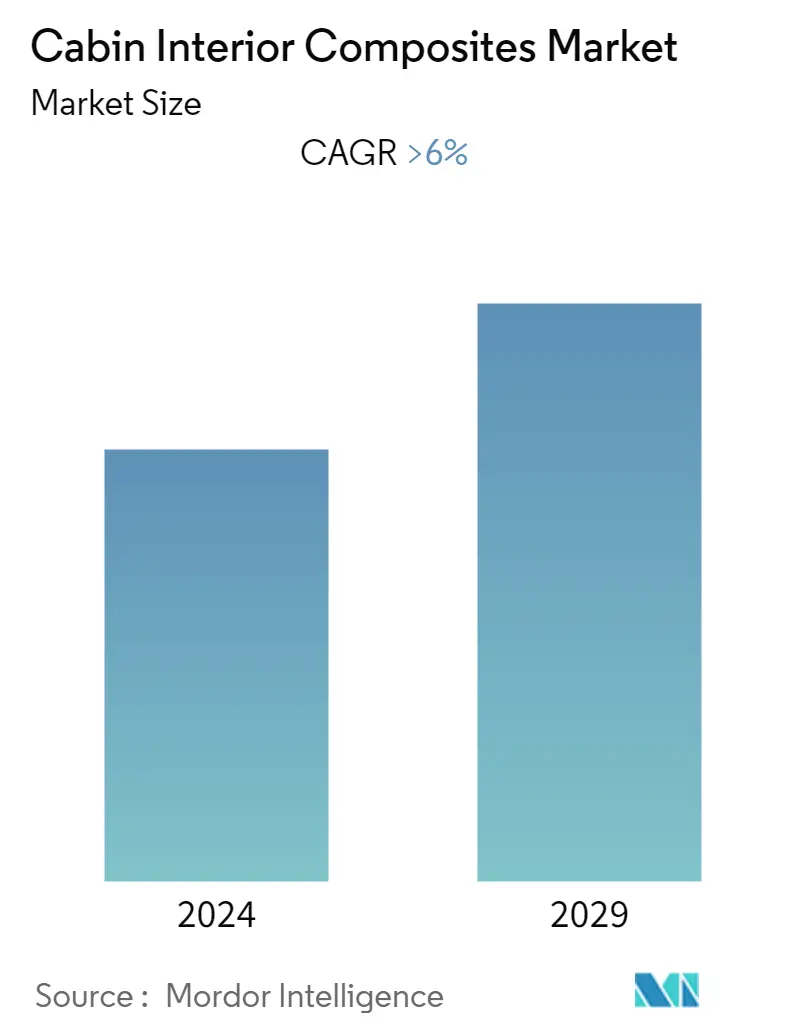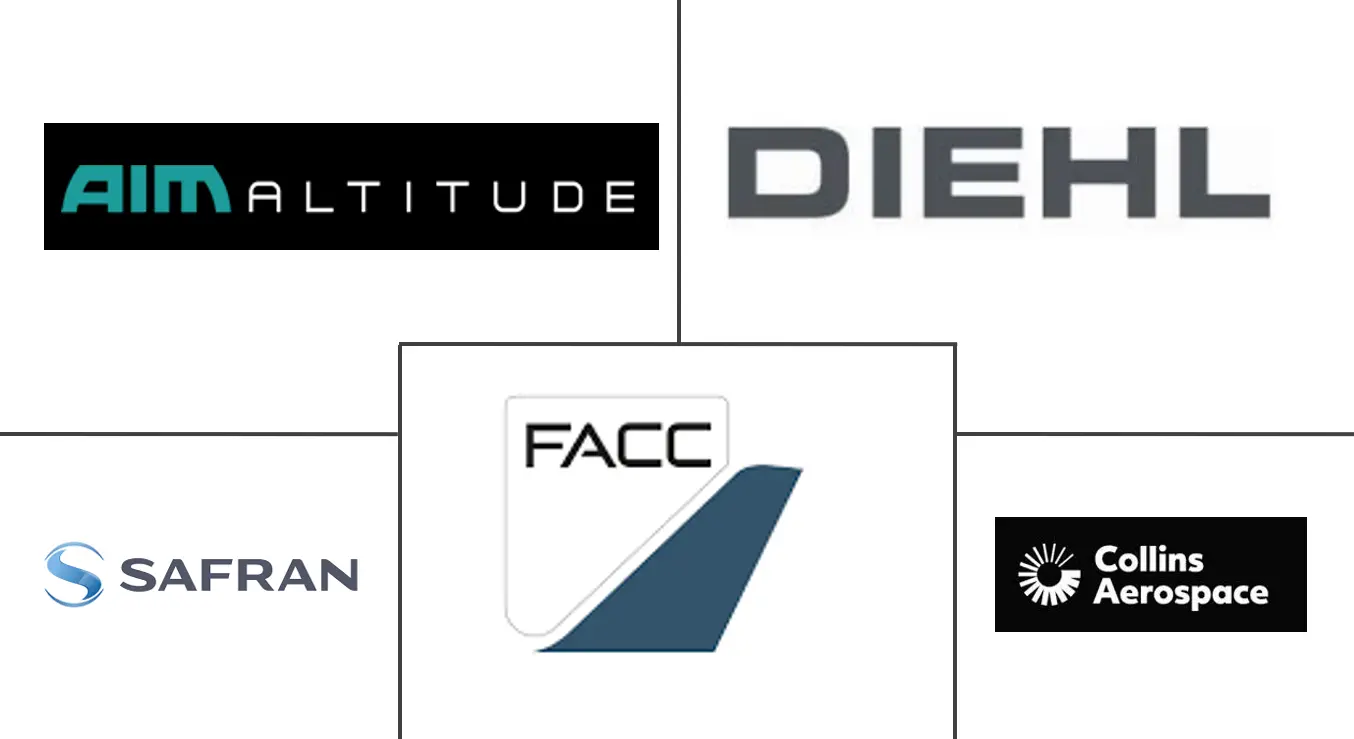Market Size of Cabin Interior Composites Industry

| Study Period | 2019 - 2029 |
| Base Year For Estimation | 2023 |
| Forecast Data Period | 2024 - 2029 |
| CAGR | 6.00 % |
| Fastest Growing Market | Asia Pacific |
| Largest Market | North America |
Major Players
*Disclaimer: Major Players sorted in no particular order |
Cabin Interior Composites Market Analysis
The Cabin Interior Composites Market is poised to grow at a CAGR of over 6% during the forecast period.
The COVID-19 pandemic has resulted in a decline in air passenger traffic, which has forced several airlines to cancel aircraft orders or postpone delivery since 2020. The passenger traffic is not anticipated to return to the pre-COVID level by 2024. Nevertheless, with the recovery in passenger traffic in 2021 as compared to that of 2020, some airlines have started ordering and taking deliveries of new aircraft, which is expected to support the growth of the cabin interior composites market.
The use of composites and other advanced materials in cabin designing has led to radical changes in aircraft designs. Their inherently high strength-to-weight ratio has resulted in significant weight savings, thereby, enhancing the fuel efficiency of the aircraft.
The overall market growth is an outcome of the organic growth of the aviation industry, as large numbers of aircraft deliveries scheduled during the forecast period will promote the use of composites for designing the aircraft cabin and drive the integrated efforts of both aircraft OEMs and aftermarket cabin integrators.
Emerging technologies, such as automated fiber placement (AFP) techniques, are enhancing the scope of integrating advanced materials into sophisticated cabin interior designs, while also reducing the aircraft's turnaround time (TAT).
Cabin Interior Composites Industry Segmentation
The cabin interior composites market considers the different players that offer either or all of the following aircraft cabin components: floor, sidewalls and ceiling panels, lavatory panels, overhead stowage bins, seat back-panel, ducts, and others.
The scope of the study does not include military aircraft and general aviation aircraft other than business jets. The market estimates are inclusive of both the linefit and retrofit aspects of the cabin interior composites market. The dominant market players have been selected, based on their association with prominent commercial aircraft programs.
The cabin interior composites market is segmented by aircraft type into narrow-body aircraft, wide-body aircraft, regional aircraft, and business jets. In terms of end-user, the market is segmented into OEM and aftermarket. The report provides market size and forecast for the major countries across all the regions. For each segment, the market size and forecast are provided by value (USD billion).
| Aircraft Type | |
| Narrow-body Aircraft | |
| Wide-body Aircraft | |
| Regional Aircraft | |
| Business Jets |
| End-user | |
| OEM | |
| Aftermarket |
| Geography | ||||||
| ||||||
| ||||||
| ||||||
| ||||||
|
Cabin Interior Composites Market Size Summary
The Cabin Interior Composites Market is experiencing a positive trajectory, driven by the recovery of the aviation industry and the increasing adoption of advanced materials in aircraft design. The integration of composites in cabin interiors has revolutionized aircraft design, offering significant weight savings and enhanced fuel efficiency due to their high strength-to-weight ratio. This market growth is supported by the organic expansion of the aviation sector, with numerous aircraft deliveries scheduled, promoting the use of composites in cabin design. Emerging technologies, such as automated fiber placement techniques, are further expanding the potential for advanced materials in sophisticated cabin interiors, while also reducing aircraft turnaround times. The demand for narrow-body aircraft, particularly from low-cost carriers, is expected to rise, with significant orders from major airlines, contributing to the market's expansion.
The Asia-Pacific region is anticipated to be a major market for cabin interior composites, fueled by the growing demand for commercial aircraft and a robust recovery in domestic air travel. Despite slower international recovery, the region's strong domestic demand, particularly in China and India, is driving aircraft procurement and cabin interior modernization. Prominent market players, including Collins Aerospace, Diehl Stiftung & Co. KG, and Safran SA, are leveraging their expertise in composite structures and design automation to create cost-effective, next-generation cabin components. The use of composites offers advantages such as corrosion resistance, high fatigue strength, and durability, making them ideal for cabin construction. This trend is further supported by collaborations between aircraft OEMs and tier-I cabin interior designers, aiming to optimize passenger comfort and fuel efficiency in aircraft cabins.
Cabin Interior Composites Market Size - Table of Contents
-
1. MARKET DYNAMICS
-
1.1 Market Overview
-
1.2 Market Drivers
-
1.3 Market Restraints
-
1.4 Industry Attractiveness - Porter's Five Forces Analysis
-
1.4.1 Threat of New Entrants
-
1.4.2 Bargaining Power of Buyers/Consumers
-
1.4.3 Bargaining Power of Suppliers
-
1.4.4 Threat of Substitute Products
-
1.4.5 Intensity of Competitive Rivalry
-
-
-
2. MARKET SEGMENTATION (Market Size and Forecast by Value - USD billion, 2018 - 2027)
-
2.1 Aircraft Type
-
2.1.1 Narrow-body Aircraft
-
2.1.2 Wide-body Aircraft
-
2.1.3 Regional Aircraft
-
2.1.4 Business Jets
-
-
2.2 End-user
-
2.2.1 OEM
-
2.2.2 Aftermarket
-
-
2.3 Geography
-
2.3.1 North America
-
2.3.1.1 United States
-
2.3.1.2 Canada
-
-
2.3.2 Europe
-
2.3.2.1 Germany
-
2.3.2.2 United Kingdom
-
2.3.2.3 France
-
2.3.2.4 Rest of Europe
-
-
2.3.3 Asia-Pacific
-
2.3.3.1 China
-
2.3.3.2 Japan
-
2.3.3.3 India
-
2.3.3.4 Rest of Asia-Pacific
-
-
2.3.4 Latin America
-
2.3.4.1 Brazil
-
2.3.4.2 Mexico
-
2.3.4.3 Rest of Latin America
-
-
2.3.5 Middle-East and Africa
-
2.3.5.1 United Arab Emirates
-
2.3.5.2 Saudi Arabia
-
2.3.5.3 Rest of Middle-East and Africa
-
-
-
Cabin Interior Composites Market Size FAQs
What is the current Cabin Interior Composites Market size?
The Cabin Interior Composites Market is projected to register a CAGR of greater than 6% during the forecast period (2024-2029)
Who are the key players in Cabin Interior Composites Market?
AIM Altitude Limited (AVIC), Diehl Stiftung & Co. KG, FACC AG, Safran SA and Collins Aerospace (Raytheon Technologies Corporation) are the major companies operating in the Cabin Interior Composites Market.

